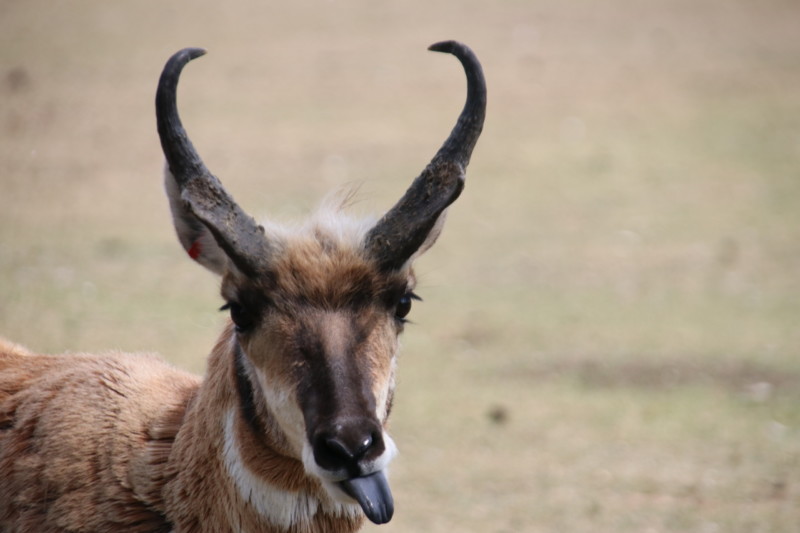The Pronghorn
Antilocapra americana
The Cree name for the Pronghorn is apistacihkos and the scientific name is Antilocapra (antelope-goat) americana (found in the Americas) and are not either goat or antelope, or even deer. They are in the Order of even-toed mammals (Cetartiodactyla) and the Family of Antilocapridae of which they are the only representative. They are not directly related to any other species on Earth and are only found on the Great Plains of Canada, the United States, and Mexico. Until science learned more about their physiology and genetics they were erroneously called antelope by Europeans. Various indigenous peoples called them small caribou, small deer or pale deer. Like the Bison with which they shared the ecosystem, they once numbered in the millions and may even have outnumbered the Bison. They have been in North America for over a million years and have outlasted the cheetah-like animals that once preyed on them. The Pronghorn’s closest living relatives are the Giraffe and the Okapi.
The Pronghorn has a deer-like body standing at about 107 cm at the shoulder and weighing 40 to 65 kilograms with females being slightly smaller and lighter weight. The upper body is tan to brown with the underparts white. Males have a black mask on the front of their faces from their eyes down to the nose and a black patch on the neck under their jaw. There are also white patches on the neck and chest as well as a white rump. The tail is short at 10 cm and surrounded with stiff white hairs. When alerted to danger, muscles in the rump will stiffen and cause those hairs to puff up. This acts as a warning signal to others and can be seen several kilometers away. Their large, wide-set eyes are suited to living in wide-open relatively tree-less spaces and they can detect movement up to 3 km away. Their main defence is speed and they can sprint at 96 km/hr for short periods and run at 56 km/hr for over 32 kilometers of distance. Their large hearts and lungs enable them to achieve the speed and endurance. When there is no place to hide, an animal must have speed to survive. When there were regular prairie fires and severe droughts, the pronghorn were suited to moving quickly and migrating to safer, more suitable places. They are not jumpers and fenced ranch lands have impeded their movements. They will crawl under fences if there is enough space.
The horns of Pronghorn are unique in that they are branched with a forward facing prong. Male horns are about 50 cm long and female horns are shorter at 10 cm and without the prong. The other unique thing is that they will shed the outer covering of the horn and then grow a new one over the permanent bony core. The horn, like all horns of other hoofed animals, is made of keratin which is the same material that makes up our hair and fingernails. (The various deer species have antlers, which are bone and are shed every year.)
Pronghorn live in small groups in nicer weather and mass together in larger herds in winter. As a species, since they may cover large areas of the continent in their search for food and suitable habitat, they are able to tolerate the extremes of temperatures found from southern Alberta and Saskatchewan down to the southwestern deserts, from 50 C to -45 C. Their main food sources are forbs (flowering, broad-leafed, non-woody plants), grasses, shrubs, sometimes cactus and sagebrush or commercial crops. The life span of Pronghorn in the wild is estimated at 9 to 10 years and a few years longer in captivity. To compensate for the relatively short life, two young per female are usually born in May or June with the life expectancy for the young at 40% by mid-summer. The fawns, weighing from 2 to 5 kg spend the first few days lying quietly in tall grass while the mother browses. In only a day or so the young will be able to sprint at 38 km/hr. The main predators of Pronghorn are Coyotes, Bobcats, and Eagles. Human beings have had the greatest impact on the population of Pronghorn with hunting, poaching, habitat disruption by farming and ranching, damming and diversion of waterways. From many millions of animals to only about 20,000 in the 1920s, the Pronghorn has been the subject of many wildlife protection efforts. There is now limited hunting allowed in many areas of North America. They are currently considered of Least Concern on the IUCN Red List. (International Union for Conservation of Nature and Natural Resources)
Some links to check out:
https://www.aaanativearts.com/what-is-the-cultural-significance-of-pronghorns-to-native-americans


